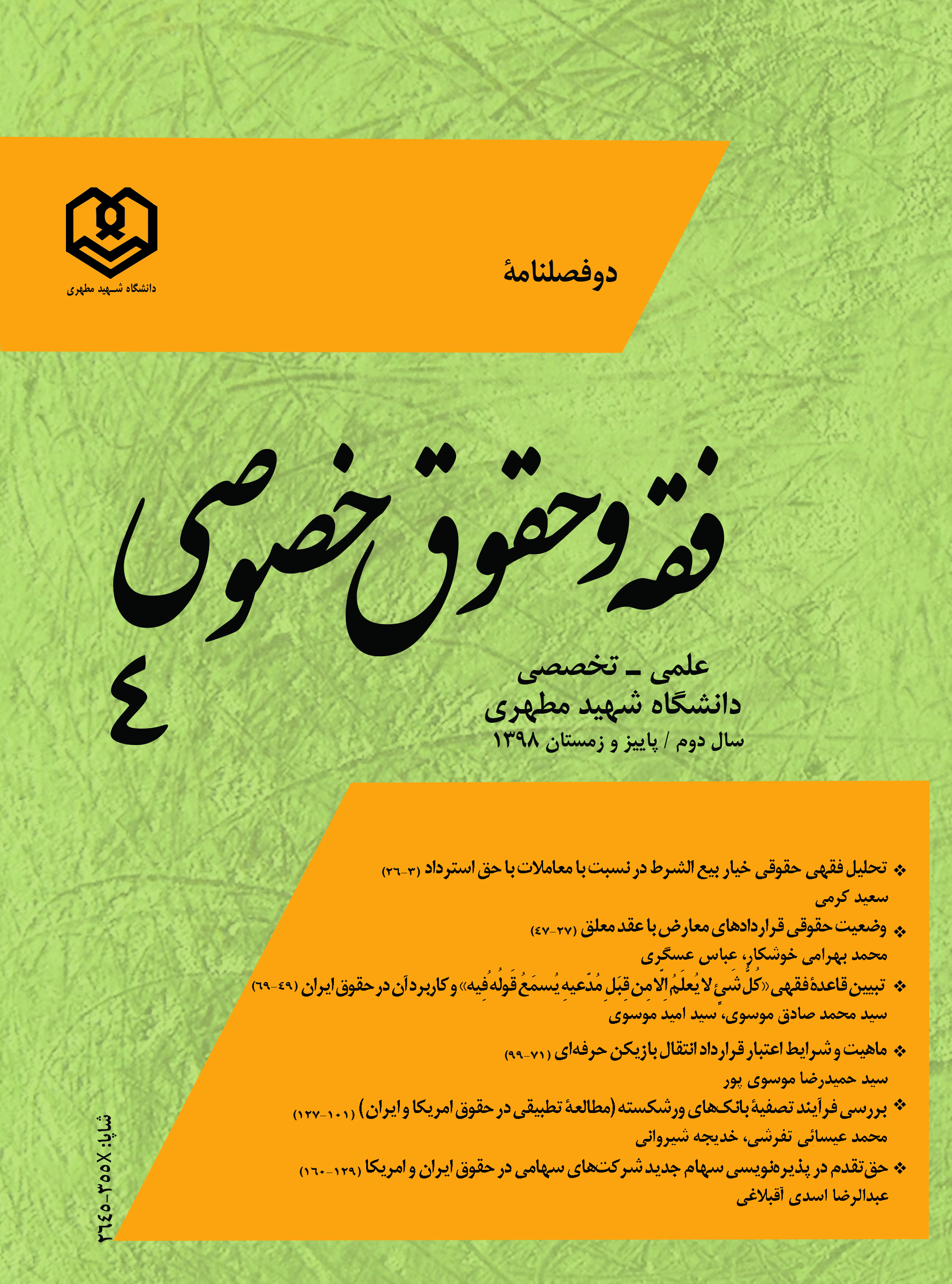بررسی فرآیند تصفیۀ بانک¬های ورشکسته (مطالعۀ تطبیقی در حقوق امریکا و ایران)
محورهای موضوعی : فقه مدنی حقوق خصوصیمحمد عیسائی تفرشی 1 , خدیجه شیروانی 2
1 - استاد دانشگاه تربیت مدرس
2 - دانشآموخته دوره دکتری فقه و حقوق خصوصی دانشگاه شهید مطهری
کلید واژه: بانک, ورشکستگی, نظام گزیر, تصفیه, حقوق امریکا, حقوق ایران.,
چکیده مقاله :
چکیده: توجه به ورشکستگی بانک ها و تأثیرات بسیار منفی آن در اقتصاد کشور، از بحران بزرگ اقتصادی که در سال 1929 در امریکا شروع شد و پس از آن به تمام دنیا سرایت کرد، آغاز شد و قانونگذاران به این نتیجه رسیدند که مقررات عام ورشکستگی شرکت های تجاری برای رسیدگی به ورشکستگی بانک ها ــ که شرکت تجاری محسوب می شوندــ کفایت نمی کند. بر این اساس، در ایالات متحدۀ امریکا سعی شده است با توجه به نقش بانک ها در اقتصاد کشور و تفاوت هایی که با سایر شرکتهای تجاری دارند، مقررات خاصی برای ورشکستگی آنها در نظر بگیرند. در این کشور نظام حقوقی حاکم بر ورشکستگی بانک ها به «Resolution Regime» معروف است که به «گزیر یا حل و فصل» ترجمه شده است. مهم ترین اهداف این نظام عبارتند از پیشگیری از اختلال های زنجیرهای در نظام مالی کشور، ادامه یافتن خدمات کلیدی بانک ها و عدم تحمیل عواقب ورشکستگی این بنگاه ها بر دولت و مؤدیان مالیاتی. در حقوق ایران نظام ورشکستگی بانک ها به طور کامل از نظام ورشکستگی شرکت ها جدا نیست و در صورتی که بانکی ورشکست گردد، مقررات قانون تجارت در زمینۀ ورشکستگی مقررات عام، و سایر مقررات پولی و بانکی خاص محسوب می شوند. و در نتیجه، در صورت سکوت مقررات خاص، مقررات عام قانون تجارت در زمینۀ ورشکستگی اعمال می گردند. در حقوق امریکا تصفیه، آخرین روش برخورد با بانک ورشکسته است، در حالی که در حقوق فعلی ایران با توجه به اینکه روش جایگزینی برای تصفیه وجود ندارد، به محض صدور حکم ورشکستگی، بانک وارد فرآیند تصفیه میشود.
Abstract: It was after the 1929 Great Recession in the United States that the world economy suffered heavy losses and Iranian officials began paying attention to the bankruptcy of the banks and its highly negative impacts on the national economy. Consequently, the lawmakers came to the conclusion that rules and regulations on bankruptcy of the commercial corporations are not sufficient for verifying bankruptcy of the banks – which are considered commercial corporations in kind. On this basis, the United States has tried to consider certain rules and regulations for bankruptcy of banks, thanks to their role in national economy and their differences from the commercial corporations. The bankruptcy code for banks and financial institutions in the United States is called Resolution Regime. It is the government’s legal framework that resolves a failed bank in an orderly way to prevent the collapse of financial markets and the country’s financial system, to continue key services by the banks and to prevent the burden of bankruptcy on the government and taxpayers. In Iranian law, the bankruptcy regime of the banks is not a hundred percent apart from the bankruptcy of the corporations. In case of the bankruptcy of a bank, the Trade Law rules and regulations on bankruptcy will be considered as general rules and other monetary and banking rules and regulations will be particular ones. In case of the silence of the particular laws, the general rules and regulations will be applicable in case of the bankruptcy of the banks. In U.S. law, liquidation is the last step to deal with a bankrupt bank, while in Iranian law - since there is no substitute method for liquidation - the bankrupt bank starts liquidation immediately after receiving the order of bankruptcy.
منابع
- اسکینی، ربیعا. (1388) حقوق تجارت: ورشکستگی و تصفیه امور ورشکسته، تهران: انتشارات سمت.
- ستوده تهرانی، حسن. (1393) حقوق تجارت، تهران: انتشارات دادگستر.
- شیروانی، خدیجه. (1398) «بررسی نظام حقوقی حاکم بر ورشکستگی بانک¬ها (مطالعه تطبیقی در حقوق امریکا، ایران، با تأکید بر موازین فقه امامیه»، رسالۀ دکتری، دانشگاه شهید مطهری.
- صقری، محمد. (1388) حقوق بازرگانی «ورشکستگی»، تهران: شرکت سهامی انتشار،
- کاویانی، کوروش. (1391) حقوق ورشکستگی، تهران: نشر میزان.¬¬¬¬¬
- Ambrasas, Tomas. (2015) Bank Resolution Regime. Balancing Private and Public Interests, A Comparative Analysis, Doctoral Dissertation, Vilnius, Basel.
- Black, H.C. (1999) Black's Law Dictionary, Editor: Bryan A. Garner, 7th ed., West Publishing Company.
- Bremer, C.D. (1935) American Bank Failures, New York: Columbia University Press.
- Federal Deposit Insurance Corporation. (2016) Financial Institution Employee's Guide to Deposit Insurance.
- https://www.fdic.gov/deposit/deposits/index.html.
- Kaufman, George. (2004) “Depositor Liquidity and Loss Sharing in Bank Failure Resolutions”, Contemporary Economic Policy.
- Marino, James A, & Rosalind L. Bennett. (1999) “The Consequences of National Depositor Preference, FDIC Banking Review, Volume 12, No. 2.
- Ragalevsky, Stanly V. & Sarah J. Ricardi, (December 2009) “Anatomy of a Bank Failure”, Banking Law Journal.
- Thomson, James B. (1994) “The National Depositor Preference Law,” Federal Reserve Bank of Cleveland Economic Commentary.


